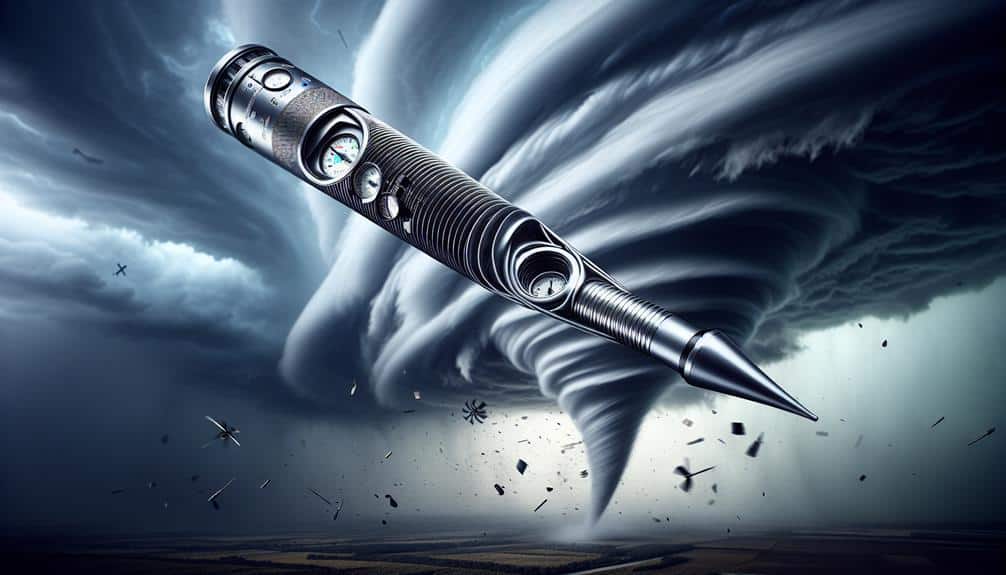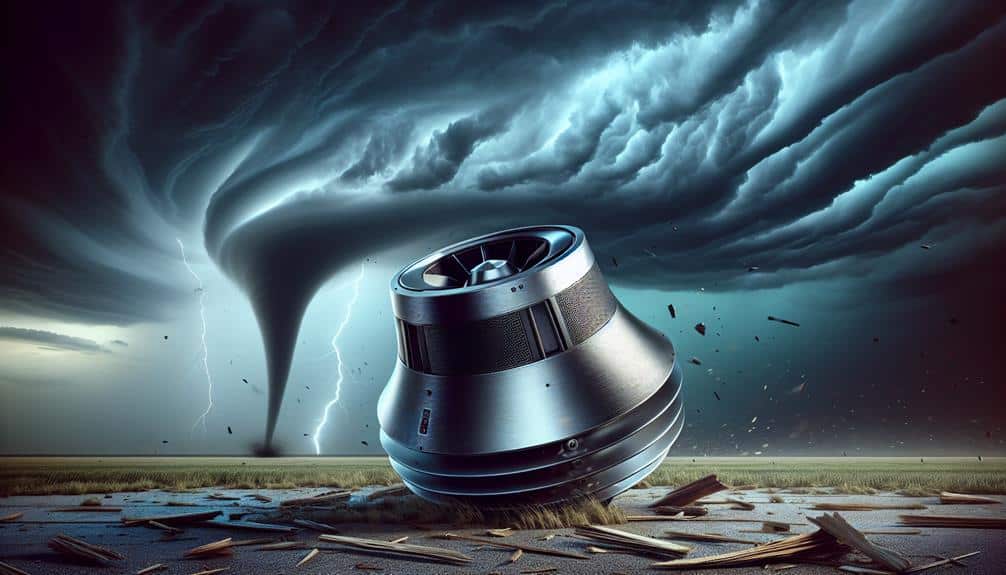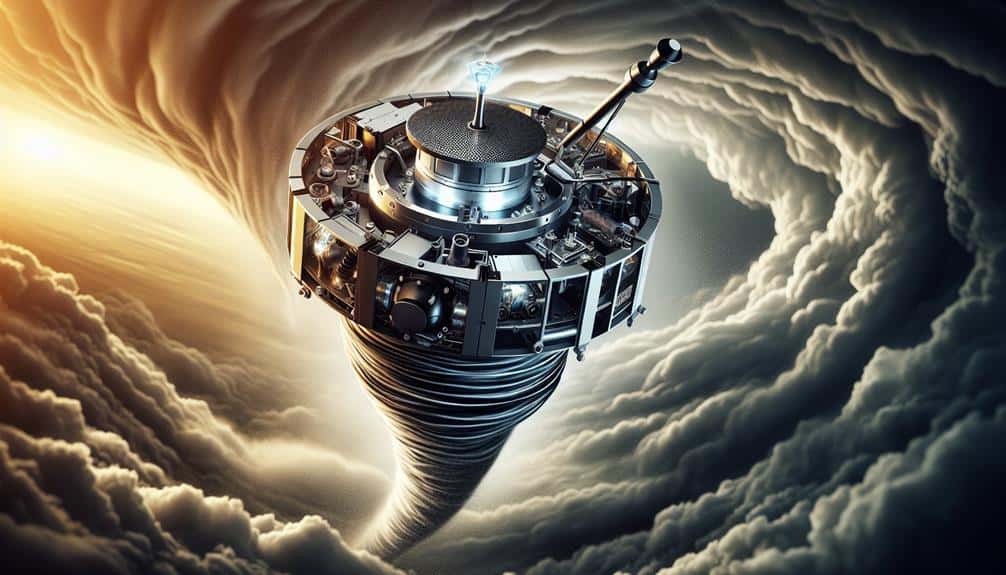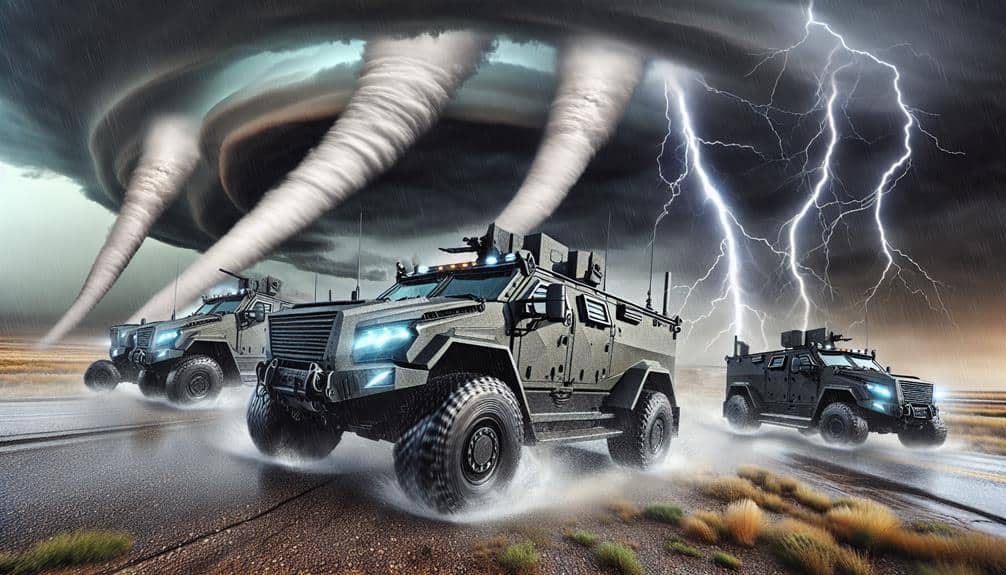For in-depth tornado field research, we can rely on seven top lightweight probes: Tornado Probe Alpha, Cyclone Tracker 3000, WindScout Mini, StormChaser X1, TwisterLite 200, VortexFinder Pro, and Tempest Sentry. Each probe is engineered with advanced sensors for accurate data capture, including wind speed, temperature, and barometric pressure. These probes boast durable, weather-resistant designs for resilience against harsh tornado conditions and seamless integration with existing systems. Their compact and ergonomic structures ensure effortless deployment and transport. Further insights await as we explore the specific capabilities and advantages of these remarkable tools for storm tracking and analysis.
Key Points
- Tornado Probe Alpha offers precise readings with advanced sensors and a lightweight, compact design for easy deployment.
- Cyclone Tracker 3000 provides continuous updates and durable, lightweight construction for harsh weather conditions.
- WindScout Mini ensures portability, robust construction, and impressive battery life for real-time tornado data collection.
- StormChaser X1 integrates advanced meteorological sensors with a lightweight, aerodynamic design for detailed tornado data.
Tornado Probe Alpha
Tornado Probe Alpha employs advanced sensors and lightweight materials to enhance data collection in severe weather conditions. We've designed this probe to maximize sensor accuracy, ensuring the most precise readings possible when tracking tornadoes. Our sensors measure various parameters, including wind speed, temperature, and barometric pressure, with unparalleled accuracy. This precision is vital for building reliable models and forecasts.
Regarding battery life, Tornado Probe Alpha excels. It operates on a long-lasting, rechargeable battery, allowing extended field deployment without the constant need for recharging. This capability is essential for capturing data throughout an entire storm cycle, providing a thorough dataset for analysis.
Field deployment is streamlined thanks to its lightweight construction and compact design. We can easily transport and position the probe in key locations without requiring heavy equipment or extensive manpower.
Once deployed, data transmission is seamless. The probe utilizes a robust wireless communication system to transmit real-time data back to our central database, ensuring we receive essential information immediately. This feature enables quick decision-making and enhances our ability to respond to evolving weather conditions.
Cyclone Tracker 3000
We'll now examine the Cyclone Tracker 3000, focusing on its advanced tracking technology, durability, and portability.
This device employs state-of-the-art sensors for precise real-time data collection.
Its robust design guarantees it withstands harsh weather conditions, while its lightweight nature makes it easy to deploy.
Advanced Tracking Technology
Harnessing cutting-edge advancements, the Cyclone Tracker 3000 revolutionizes tornado tracking with its unparalleled precision and real-time data capabilities. By integrating satellite imagery and real-time tracking, this probe provides immediate updates on tornado movements, ensuring that we stay ahead of unpredictable weather patterns.
The sophisticated remote sensing technology embedded within the Cyclone Tracker 3000 allows us to analyze atmospheric conditions with remarkable detail, facilitating accurate predictions and timely interventions.
The device's advanced tracking technology empowers us to monitor tornado development and path changes instantaneously. This means we're not just reacting to tornadoes but anticipating their behavior, which is essential for safeguarding lives and property.
The Cyclone Tracker 3000's capabilities are bolstered by its seamless integration with existing weather monitoring systems, making it an indispensable tool in our arsenal.
Here's what sets the Cyclone Tracker 3000 apart:
- Satellite Imagery: Leverages high-resolution satellite data for precise storm visualization.
- Real-Time Tracking: Provides continuous updates on tornado positions, enhancing situational awareness.
- Remote Sensing Technology: Utilizes advanced sensors to monitor and predict weather patterns with high accuracy.
Durability and Portability
The Cyclone Tracker 3000's sturdy construction and lightweight design guarantee both durability and portability, making it an essential tool for field deployment in severe weather conditions. Its field durability is unmatched, allowing us to confidently deploy it in the harshest environments without worrying about structural integrity.
The compact size ensures we can easily transport and position the device, even in remote locations where accessibility is limited. Portability is a crucial factor for any field researcher, and the Cyclone Tracker 3000 excels in this aspect. Its rugged construction doesn't compromise its weight, allowing for easy handling and quick deployment.
The materials used in its build are carefully selected to withstand the rigors of fieldwork, including high winds, rain, and flying debris. This guarantees that we can focus on data collection rather than equipment maintenance. Furthermore, the Cyclone Tracker 3000's design incorporates features that enhance its usability in the field.
Its ergonomic handles and intuitive setup make it easy to operate under pressure. By combining portability with robust, rugged construction, this probe stands out as a dependable choice for those of us committed to advancing tornado research.
WindScout Mini

WindScout Mini offers a compact yet powerful solution for gathering crucial tornado data in real-time. Its small size belies its capability, making it a top choice for field researchers.
WindScout Mini's portability is one of its standout features; we can easily transport and deploy it in various environments, allowing us to chase tornadoes without being weighed down by heavy equipment. Additionally, its impressive battery life guarantees we can gather continuous data over extended periods without frequent recharges.
The WindScout Mini excels in field research applications due to its compact design. It's designed to withstand the harsh conditions often encountered during tornado events. The probe's robust construction doesn't compromise its lightweight nature, ensuring reliability and ease of use.
Here are three key aspects of the WindScout Mini:
- Portability: We can carry the WindScout Mini effortlessly, making it ideal for rapid deployment in changing weather conditions.
- Battery Life: The extended battery life supports prolonged data collection sessions, enhancing our ability to capture thorough tornado data.
- Compact Design: Its small footprint allows for easy setup and operation, even in the most challenging environments.
StormChaser X1
StormChaser X1 integrates advanced meteorological sensors to provide detailed tornado data with high accuracy. This stormchaser equipment is designed for those of us who demand precision and reliability in the field.
Equipped with cutting-edge anemometers, barometers, and hygrometers, it captures a wide range of atmospheric variables. The data collected is invaluable for understanding tornado dynamics and improving predictive models.
In the field of field safety, the StormChaser X1 excels. Its lightweight, aerodynamic design guarantees easy deployment and retrieval, even in unpredictable conditions. The probe's sturdy construction withstands high winds and debris impact, crucial for minimizing risk during intense stormchasing activities.
Additionally, the integrated GPS module allows real-time tracking, making sure we can monitor the probe's location and retrieve it efficiently.
Moreover, StormChaser X1's user-friendly interface simplifies data collection and analysis. The onboard data loggers store large datasets, while wireless communication capabilities enable remote data access. This means we can stay out of harm's way while still gathering essential information.
TwisterLite 200

Let's examine the TwisterLite 200 by focusing on its design and build quality, data collection efficiency, and durability in extreme conditions.
We need to assess how its lightweight construction impacts its operational performance.
Additionally, we'll evaluate its resilience when subjected to the harsh environments typical of tornadoes.
Design and Build Quality
The TwisterLite 200's design integrates advanced aerodynamics with durable, lightweight materials to guarantee peak performance during tornado tracking missions. We focused on material selection to secure weather resistance under extreme conditions. Constructed from high-quality aluminum and reinforced polymers, the TwisterLite 200 remains resilient against wind, rain, and debris. This blend of materials not only enhances durability but also minimizes weight, allowing for easy deployment.
Our ergonomic design prioritizes user comfort, providing a hassle-free experience during high-stress field operations. The probe's grip and balance are meticulously crafted to reduce strain, making it easier to handle and transport. This attention to ergonomic detail secures that long hours in unpredictable weather won't compromise our team's efficiency or safety.
To summarize the design and build quality of the TwisterLite 200, consider these key aspects:
- Material Selection and Weather Resistance:
- High-quality aluminum and reinforced polymers
- Exceptional durability against wind, rain, and debris
- Ergonomic Design and User Comfort:
- Balanced and easy-to-grip structure
- Designed to reduce user strain during prolonged use
- Lightweight Construction:
- Facilitates quick and easy deployment
- Enhances mobility in the field
Data Collection Efficiency
With the TwisterLite 200, we leverage cutting-edge sensors and data acquisition systems to guarantee thorough and accurate tornado tracking. This probe excels in data accuracy, providing us with high-resolution measurements that are essential for understanding tornado dynamics. Through seamless technology integration, the TwisterLite 200 ensures that we gather critical meteorological data without any hitches.
Field accessibility is another strong suit of the TwisterLite 200. Its lightweight design allows us to deploy it swiftly in various terrains, ensuring that our data collection isn't hindered by logistical challenges. The probe's compact form factor and ease of setup make it an invaluable tool for researchers who need to act quickly during unpredictable weather conditions.
Real-time monitoring is a game-changer for us. The TwisterLite 200 is equipped with advanced communication modules that provide live data feeds. This enables us to make immediate decisions based on current conditions, enhancing our ability to track tornadoes as they evolve. By combining data accuracy with real-time monitoring, we can develop more precise models, ultimately improving our predictive capabilities. This level of efficiency empowers us to push the boundaries of tornado research, free from the constraints of outdated technology.
Durability in Extreme Conditions
Our TwisterLite 200 is engineered to withstand the harshest weather conditions, ensuring reliable performance during intense tornado events. The primary focus is on durability, allowing us to gather critical data without equipment failure. This durability stems from our meticulous attention to three key factors:
1. Temperature resistance and impact resistance:
The TwisterLite 200 is constructed with materials capable of enduring extreme temperatures, from freezing cold to scorching heat. Its robust casing provides exceptional impact resistance, protecting the internal components from debris and high-velocity impacts common during tornadoes.
2. Waterproofing:
In the midst of a tornado, heavy rain and moisture are inevitable. Our probe features superior waterproofing to prevent any water ingress, ensuring that the sensitive electronics remain functional throughout the storm.
3. Battery life:
Field researchers need equipment that can last through extended periods of severe weather. The TwisterLite 200 boasts a high-capacity battery, designed to maintain power for prolonged durations, reducing the need for frequent recharges.
VortexFinder Pro
Engineers designed the VortexFinder Pro to enhance data collection through its advanced sensor array and sturdy, lightweight construction. By employing state-of-the-art sensor technology, the VortexFinder Pro guarantees unparalleled data accuracy, which is essential for in-depth tornado analysis. These sensors are meticulously calibrated to detect minute changes in atmospheric conditions, providing us with real-time data that can be crucial during field deployment.
When we're out in the field, the VortexFinder Pro's lightweight design simplifies transport and setup. This probe is engineered to withstand the harshest conditions while maintaining its operational integrity. Its compact form factor doesn't compromise its ability to capture high-resolution data, making it an indispensable tool for any storm-chasing expedition.
Real-time monitoring capabilities set the VortexFinder Pro apart. We can track storm development instantaneously, making split-second decisions based on live data feeds. This feature empowers us to react swiftly to changing conditions, maximizing both our safety and the quality of our research.
The advanced sensor array and sturdy construction of the VortexFinder Pro make it an exemplary tool for capturing the complex dynamics of tornadoes, providing us with the freedom to push the boundaries of meteorological research.
Tempest Sentry

Building on the innovations of the VortexFinder Pro, the Tempest Sentry offers enhanced durability and even more precise atmospheric measurements for extreme weather analysis. Our design team has focused on improving data accuracy through meticulous sensor placement, making sure that we capture the most essential atmospheric variables.
The Tempest Sentry's robust construction allows it to withstand harsh tornado environments, making it a reliable tool for field researchers.
The Tempest Sentry excels in remote monitoring capabilities, providing real-time updates that are important for timely decision-making. This feature allows us to track ongoing weather events without the need for constant physical presence, thereby granting greater freedom and flexibility in our research operations.
The integration of advanced telemetry systems ensures seamless data transmission from the field to our analysis centers.
Key features of the Tempest Sentry include:
- Data Accuracy and Sensor Placement: Optimized sensor locations enhance the precision of atmospheric measurements, capturing data points that are essential for accurate weather forecasting.
- Remote Monitoring and Real-Time Updates: Advanced telemetry systems enable continuous data flow, giving us instant access to important information.
- Enhanced Durability: Built to withstand extreme weather conditions, ensuring long-term use and reliability.
With the Tempest Sentry, we're better equipped to understand and predict tornado behaviors, pushing the boundaries of what's achievable in meteorological research.
Frequently Asked Questions
What Materials Are Commonly Used in Lightweight Tornado Probes?
We commonly use composite materials in lightweight tornado probes, incorporating titanium alloys for strength. Carbon fiber and Kevlar fibers provide durability without adding excess weight, ensuring our probes are both resilient and easy to deploy in the field.
How Are Tornado Probes Powered During Field Research?
When considering how tornado probes are powered during field research, we analyze power source options like batteries and solar panels. These options enhance remote monitoring capabilities, giving us the freedom to track storms without constant manual intervention.
Can These Probes Be Used in Other Severe Weather Conditions?
Like Swiss Army knives for meteorology, our probes aren't just for tornadoes. They excel in hurricane tracking, thunderstorm monitoring, flood prediction, and even avalanche detection. Versatile and reliable, they adapt to various severe weather conditions seamlessly.
What Are the Safety Protocols for Deploying Tornado Probes?
We must follow strict safety precautions during the deployment process. These include monitoring real-time weather data, maintaining a safe distance, and ensuring quick retrieval routes. Proper training and communication are essential to minimize risks while maximizing data collection.
How Do Tornado Probes Transmit Data to Researchers?
Like the flow of air currents, tornado probes transmit data through wireless methods, fostering research collaboration opportunities. Our data transmission methods include satellite uplinks and radio frequencies, ensuring precise, real-time information reaches us despite the storm's chaos.

